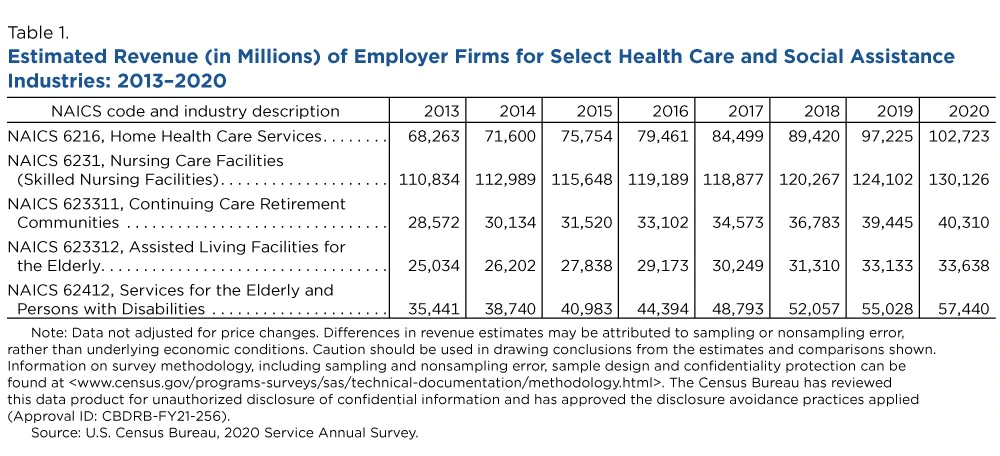Older adults can save tens of thousands of dollars annually by choosing assisted living communities over aging in place in their homes.
Unlike point solutions, Inspiren unifies resident safety, care planning, staffing, and emergency response into a single AI-powered platform.
An artificial intelligence-powered virtual assistant platform for senior living and care providers.

 The Census knows the growth and potential explosion of care needs and older adults. Consider
The Census knows the growth and potential explosion of care needs and older adults. Consider 

Comments
From Michael Skaff via LinkedIn
Also, the consolidation that is happening will also increase the value/necessity of the right technologies in place...in addition to the growing labor shortage.
Also: Argentum's Largest Senior Living Providers Report
2022 Largest Provider report in descending order from Argentum.
Worth a close look in conjunction with the Census numbers and forecast.
From Wendy Goldman via LinkedIn
Major marketing campaign is needed to communicate with this important target audience. Long learning curve for mass adoption means we've got to start now.
From Monica Stynchula via LinkedIn
he 20th Century residential care models miss the mark on the 21st Century lives and changing demographics. PACE, home renovations, age-friendly communities, and similar models enable us to live with multiple chronic conditions at home. This is an exciting time in home and health care.
Thriving on Chaos
The Boy-Scout’s motto “Be Prepared” means that a scout must prepare himself by previous thinking out and practicing how to act on any accident or emergency so that he is never taken by surprise. So it is with aging, we all know that it is inescapable, and certainly coming, if we accept that or not, living in denial and trying to ignore it makes the route of aging a gamble and living reactively, kept together with glue and Band-Aids. It’s giving the business world an opportunity to thrive on this pandemonium. Massive marketing to change behavior or being content with the “exciting times of the status of home and health care” are both fuel on the fire of chaos. The senior care industry is “Thriving on Chaos” to use Tom Peters 1987 book tittle. All is expensive because there is not enough competition and demand is increasing for decades to come. An expression to use here is “There are enough suckers out there and they keep on coming” a most lousy marketing term used for decades in this blasé industry and contradicting market, driven by a negative demand, a battle between the victim and opportunist as there is lots of money in aging. Mass adoption will not occur until collective programs from the top-down (NGO’s) are created or marketing companies have produced products at scale reaching 5% - 10% of the senior population. The today’s proliferation of products and services is the same as the early days of the personal computer, at which time you had to buy software for any single purpose, i.e. a spell-checker, a grammar-checker, a disk-cleaner etc. possibly 100,000 separate software companies were there, today all to be found into one MS operating platform. So it is with long-term care, unless integrated, user-friendly supportive programs and products are established, the culture around aging and late-life living will be filled with distress and anxiety and a plethora of companies will continue to thrive on this chaotic market at work.
From Assaf Gad via LinkedIn
Interesting read from Laurie Orlov, who address the progress of technology use in senior care.
“In the past decade, there has been much talk (and media) about technology innovation in senior care. But is the commitment to investing in technology still sporadic? Is it just isolated to a demo of VR here, a few robots there, a free pilot of voice tech for those with high enough broadband speeds to benefit? Is it possible that you will still find buildings where there is no Wi-Fi access in resident rooms, only in common areas or hallways?”
How advanced is your community in using technology to provide better care and improve engagement to your residents?
technology and care
In our communities we bring first the connectivity of residents to the highest level, so that human capital is used first and technology is always second or third. This so seniors who do not like or want technology can live there with the support of their peers. We integrate technology in a passive and active way, in other words, residents can turn it on or of to their liking. Our platform is open for any technology or support program a resident or their family would like to use (buy or subscribed to) in addition to ours. This keeps our program flexible and open for whatever comes next. Simple but complex.